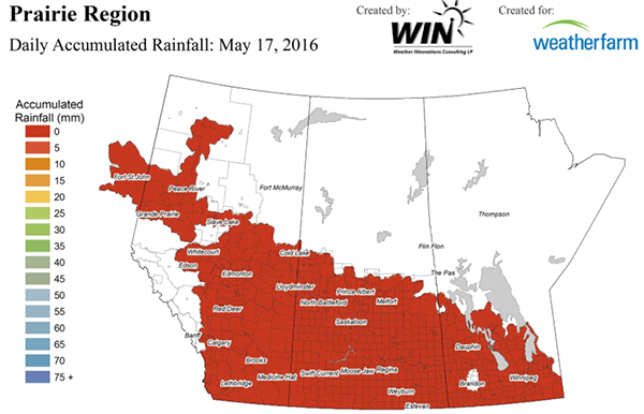Forest fires raging across the Prairies is a sign of just how dry this season is starting off to be. While there appears to be precipitation in the forecast, how much anyone gets is still like buying a lottery ticket.
Last fall, Saskatchewan and Manitoba went into the winter with very good soil moisture levels.
Since then, however, very little precipitation was received over the winter and temperatures have been above normal this spring. Surprisingly – because it doesn’t feel like it – spring precipitation has been near normal.
This lack of precipitation and snow melt is compounded with high winds that have the added effect of drying out the soil as it’s disturbed during seeding operations. So much so in fact, Twitter was abuzz with growers sharing how they were only seeding at night, or not seeding at all on those days with very high winds and temperatures combined.
Are we headed for drought? It’s far too soon to know that at this point. Any predictions that far out are akin to predicting winning the Lotto 649!
But what if conditions continue to be dry? Are there strategies you can adopt that will give the crop a better chance at reaching its maximum potential yield? According to CEO and Director of Research and Development Dr. Abdel El Hadrami at OMEX Canada, there are proven strategies that are easy to incorporate into the production plan.
“Drought stress causes the plant to lower its rate of photosynthesis,” explains El Hadrami. “Additionally, cell division is impaired and there is a loss of turgor. What this means, simply, is there is reduced growth due to reduced cell elongation and enlargement.”
The key, according to El Hadrami, is to maximize root architecture from the start. “A plant only gets one chance to develop its roots. If root development is poor from the get-go, then you are playing catch-up from that point on.”
“The best way to give the plant an optimal start is to maximize root development and plant into top soil moisture,” he says. “Applying a seed coating containing phosphate and manganese, the so-called root maker micro-nutrients, will enhance root development.”
As the season progresses, applying a foliar containing manganese with the herbicide application has proven yield benefits as well.
Impact of seed primer on root development and architecture. Courtesy of OMEX Canada.
“In a dry season, growers may not see much disease development and so may not take the sprayer out for a fungicide application,” he says. “This is the third key time to apply a foliar with phosphorus, boron, calcium, and magnesium. These micro-nutrients are critical to ensure good pollination and seed set. Additionally, these are all also nutrients that move with water – if water is in short supply, the plant will be deficient and yield will be jeopardized.”
Improved root development with the application of OMEX C3, Super C3 and Nutri-Boost on wheat root development. Courtesy of OMEX Canada.
Judicious use of foliar applied micro-nutrients can help preserve yield, rather than give up on the crop mid-season and hope for the best.











Leave A Comment